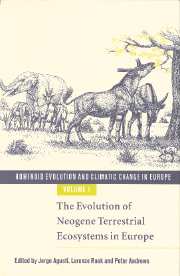Book contents
- Frontmatter
- Contents
- List of contributors
- Acknowledgements: The European Science Foundation
- 1 Introduction
- PART I Palaeogeography of the circum-Mediterranean region
- PART II Miocene mammalian successions
- 5 A critical re-evaluation of the Miocene mammal units in Western Europe: dispersal events and problems of correlation
- 6 Large mammals from the Vallesian of Spain
- 7 Trends in rodent assemblages from the Aragonian (early–middle Miocene) of the Calatayud-Daroca Basin, Aragon, Spain
- 8 The Late Miocene small mammal succession from France, with emphasis on the Rhône Valley localities
- 9 Late Miocene mammals from Central Europe
- 10 An overview on the Italian Miocene land mammal faunas
- 11 The Miocene large mammal succession in Greece
- 12 Chronology and mammal faunas of the Miocene Sinap Formation, Turkey
- 13 The Late Miocene small mammal succession in Ukraine
- PART III Palaeoenvironments: non-mammalian evidence
- PART IV Palaeoenvironments: mammalian evidence
- Index
8 - The Late Miocene small mammal succession from France, with emphasis on the Rhône Valley localities
from PART II - Miocene mammalian successions
Published online by Cambridge University Press: 15 December 2009
- Frontmatter
- Contents
- List of contributors
- Acknowledgements: The European Science Foundation
- 1 Introduction
- PART I Palaeogeography of the circum-Mediterranean region
- PART II Miocene mammalian successions
- 5 A critical re-evaluation of the Miocene mammal units in Western Europe: dispersal events and problems of correlation
- 6 Large mammals from the Vallesian of Spain
- 7 Trends in rodent assemblages from the Aragonian (early–middle Miocene) of the Calatayud-Daroca Basin, Aragon, Spain
- 8 The Late Miocene small mammal succession from France, with emphasis on the Rhône Valley localities
- 9 Late Miocene mammals from Central Europe
- 10 An overview on the Italian Miocene land mammal faunas
- 11 The Miocene large mammal succession in Greece
- 12 Chronology and mammal faunas of the Miocene Sinap Formation, Turkey
- 13 The Late Miocene small mammal succession in Ukraine
- PART III Palaeoenvironments: non-mammalian evidence
- PART IV Palaeoenvironments: mammalian evidence
- Index
Summary
Introduction
Upper Miocene localities in France are relatively numerous, but not equally distributed through time. Only three localities are allocated to the Lower Vallesian. There are abundant local faunas from the Upper Vallesian and Lower Turolian, but the Middle and Upper Turolian are poorly represented.
The fossiliferous sites occur in different areas (Fig. 8.1 and Table 8.1).
Near Lyon, in the Rhône Valley (Ain County code number 01), the oldest fossiliferous locality Jujurieux (Mein, 1985), along the banks of the Ecotay river, is embedded in Serravallian marine sands, with Foraminifera, and occurs immediately above the last marine stratum. A preliminary list was given by Mein (1985). This fauna which is more recent than La Grive L3, is characterised by new species for the Rhône Valley such as a new form of Democricetodon and a small species of Megacricetodon; the large form of Megacricetodon has disappeared. In spite of the absence of typical Vallesian elements, the strata of Jujurieux may be equivalent to the marine sands at Saint Fons (in the south suburb of Lyon) which has yielded a Hipparion mandible. An updated faunal list is given in the appendix. The locality Priay 2 (Welcomme et al., 1991) also lies just above marine sediments, at the basis of the ‘Marnes de Bresse’ Formation and has been referred to the Lower Vallesian. The locality of Douvre (Mein, 1984) is slightly younger. The sites of Amberieu 1, 2 and 3 belong to three different levels in the same formation (Farjanel & Mein, 1984). In the same area, Soblay is a doline deposit which has yielded large mammals (Viret & Mazenot, 1948) and small mammals (Mein, 1970, 1984).
- Type
- Chapter
- Information
- Hominoid Evolution and Climatic Change in Europe , pp. 140 - 164Publisher: Cambridge University PressPrint publication year: 1999
- 16
- Cited by

